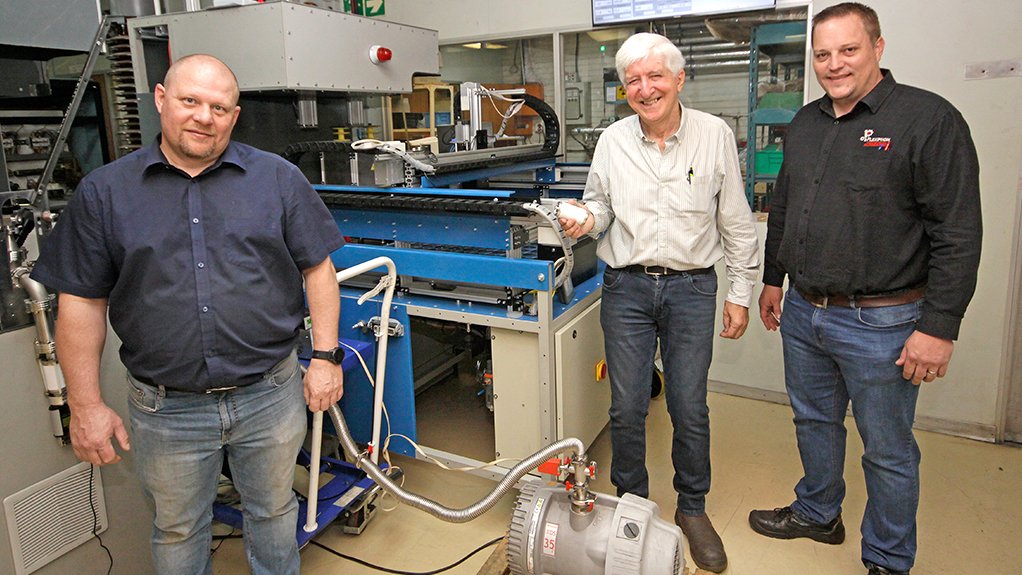Automated testing system for vacuum interrupters now operating in ACTOM MV Switchgear’s VI plant


Together (from left) VI plant manager Danie Hanekom, his predecessor John Schultz and automation specialist Wes Allan devised and developed the ingenious automated VI testing system, in which a special trolley (shown here) for carrying VIs for testing is plugged into one of the test stations.
Electromechanical equipment manufacturer Actom’s MV Switchgear division recently completed the establishment of an automated vacuum interrupter (VI) testing facility in the VI manufacturing plant at its Knights factory, in Germiston.
The automated test facility, which was completed in September this year and started operation in October, has been established to test the VIs that are being manufactured by the division for a US switchgear company that has launched the new product into the US market.
MV Switchgear undertook in the partnership agreement, signed in early 2020, to expand the production capacity and develop the manufacturing and testing capabilities of its VI plant to enable it to produce the US company’s VIs in accordance with its specific requirements.
The division is committed to manufacturing up to 20 000 of the US company’s VIs per year. The product differs substantially from the VIs that MV Switchgear manufactures in the VI plant for its own switchgear equipment, as it has, among other differences, a higher voltage rating, more stringent tolerance requirements and is more compact than the local product.
“The volume of VIs we are manufacturing for our US partner is significantly larger than the numbers we produce for our own switchgear. It was therefore essential that an automated testing facility be established in the plant to keep pace with the output of the new product,” says MV Switchgear design and development manager Rhett Kelly.
The division contracted a reputable local automation specialist, who had earlier assisted with the integration of the newly refurbished braze furnace control systems, to build a customised automated testing system to meet these requirements.
“There are four types of tests that have to be done on each new VI produced. The system consists of automated test stations for each of the test procedures, plus moveable trollies that can be plugged into each of the test stations respectively. Each trolly is equipped with a robotic arm and contains a tray holding 150 VIs for testing.
“The robotic arm is programmed to pick up each VI in turn, read the QR code to capture the serial number and insert it into the test station, where it is tested. It then picks it up and places it back in the tray,” Kelly explains, adding that the robotic arms and test procedures are all centrally controlled by a supervisory control and data acquisition system, which also automatically records and logs the test results.
“The trays have to be loaded and the trollies moved into position and plugged into the test station bays manually. But once the test procedures get under way it is a fully-automated
process from start to finish, with the different types of tests being able to be conducted simultaneously on the VIs,” he adds, noting that the testing process occurs without any human intervention.
For example, at the end of the production day the tests may be started and left to independently complete themselves overnight, he points out.
The trays for the VIs are stored in a special cabinet with environmental controls, including air purification units to protect the VIs from contamination between tests.
The different types of tests are:
- High voltage conditioning of the contacts,
- Pressure measurement using a magnetron,
- Electrical contact resistance measurement, and
- Power frequency withstand test, combined with an X-ray test.
In addition to the functions performed by the robotic arms as described above, they are programmed to adjust the contact gap of the VIs for three of the abovementioned tests, as different contact gaps apply for these tests.
“The control system for the robotic arms is also programmed to enable the robots to continue from where they left off in the testing process when the power is restored after any power interruptions, including loadshedding,” comments MV Switchgear technology development specialist Johan Jordaan.
Comments
Announcements
What's On
Subscribe to improve your user experience...
Option 1 (equivalent of R125 a month):
Receive a weekly copy of Creamer Media's Engineering News & Mining Weekly magazine
(print copy for those in South Africa and e-magazine for those outside of South Africa)
Receive daily email newsletters
Access to full search results
Access archive of magazine back copies
Access to Projects in Progress
Access to ONE Research Report of your choice in PDF format
Option 2 (equivalent of R375 a month):
All benefits from Option 1
PLUS
Access to Creamer Media's Research Channel Africa for ALL Research Reports, in PDF format, on various industrial and mining sectors
including Electricity; Water; Energy Transition; Hydrogen; Roads, Rail and Ports; Coal; Gold; Platinum; Battery Metals; etc.
Already a subscriber?
Forgotten your password?
Receive weekly copy of Creamer Media's Engineering News & Mining Weekly magazine (print copy for those in South Africa and e-magazine for those outside of South Africa)
➕
Recieve daily email newsletters
➕
Access to full search results
➕
Access archive of magazine back copies
➕
Access to Projects in Progress
➕
Access to ONE Research Report of your choice in PDF format
RESEARCH CHANNEL AFRICA
R4500 (equivalent of R375 a month)
SUBSCRIBEAll benefits from Option 1
➕
Access to Creamer Media's Research Channel Africa for ALL Research Reports on various industrial and mining sectors, in PDF format, including on:
Electricity
➕
Water
➕
Energy Transition
➕
Hydrogen
➕
Roads, Rail and Ports
➕
Coal
➕
Gold
➕
Platinum
➕
Battery Metals
➕
etc.
Receive all benefits from Option 1 or Option 2 delivered to numerous people at your company
➕
Multiple User names and Passwords for simultaneous log-ins
➕
Intranet integration access to all in your organisation


















